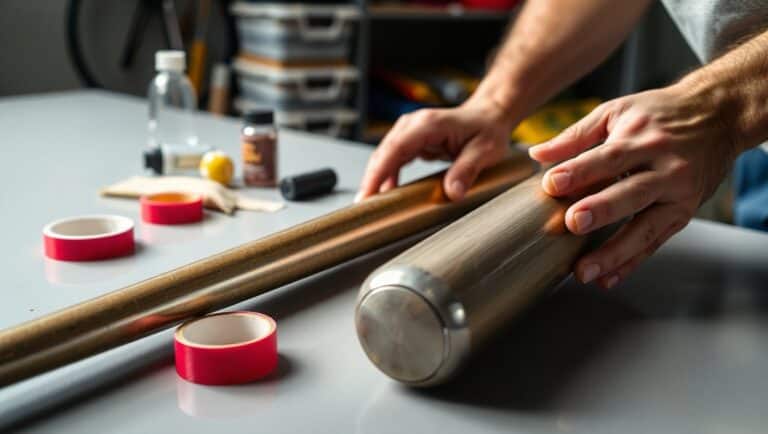Breaking In Softball Glove: Tips and Tricks for 2025!

Ever tried catching a softball with a stiff new glove? Ouch! I still remember the pain in my hand from trying to squeeze my glove. Let’s face it, a new softball glove can be as stubborn as a mule, but with the right techniques, we can turn that rigid leather into your hand’s best friend.
Breaking in a glove isn’t just about comfort (though that’s a big part of it!). It’s crucial for your performance on the field. A well-broken-in glove becomes an extension of your hand, giving you better control, feel, and ultimately, making those spectacular catches a whole lot easier.
In this guide, I’m gonna walk you through everything I’ve learned about breaking in softball gloves over the years. From quick fixes to tried-and-true methods, we’ll cover it all. So grab your new mitt, and let’s dive in!
Understanding the Anatomy of a Softball Glove
Let’s dive into the nitty-gritty of softball gloves. Trust me, knowing your glove is like knowing your best friend – it’ll make your relationship on the field so much smoother.
First up, we’ve got the palm – the heart of your glove. This is where the magic happens, where that softball’s gonna make its grand entrance. You want this part to be soft and supple, like a well-worn leather jacket. I remember my first game with a new glove – that stiff palm made catching feel like I was trying to grab balls with a piece of plywood! Not fun, let me tell you.
Then there’s the web, that fancy network between your thumb and index finger. It’s not just for show. Different web styles serve different purposes. You’ve got your basket webs, trapeze webs, H-webs, and more. Each has its own strengths. I’m partial to the H-web myself – it gives me a nice, pocket for when I am pitching, my favorite spot to play so I snagging those line drives hit right back at me.
Now, let’s talk fingers. Pretty self-explanatory, right? Well, not so fast. The finger stalls are where a lot of players neglect their break-in efforts. But trust me, flexible fingers can make or break your catching game. Don’t forget about the heel at the bottom of the palm. It’s easy to overlook, but a well-broken-in heel can make a world of difference in how your glove closes.
Now, let’s geek out about materials for a sec. Most gloves these days are leather, but not all leather is created equal. You’ve got your full-grain leather, which is top-notch but takes forever to break in. Then there’s softened leather, which is easier on the hands but might not last as long. And don’t forget the synthetic options! Sure, it was game-ready in no time, but it didn’t last very many seasons!
Remember, the structure of your glove affects how it breaks in. A stiffer glove might take longer, but it’ll hold its shape better over time. A softer glove might feel great out of the box, but you’ll probably have a loose floppy glove before you know it. It’s all about finding that sweet spot for your playing style and position.
Preparing Your Glove For The Break-In Process
Alright, team, gather ’round. We’re about to embark on the sacred journey of breaking in a new softball glove. But before we start bending and shaping, we need to prep our glove. Think of it like stretching before a workout – it’ll make the whole process smoother and prevent any, uh, “injuries” to your precious mitt.
First things first – give your glove a good clean. I know, I know, it’s brand new, why bother cleaning it? Trust me on this one. You want to start with a clean slate. I like to use a damp cloth to wipe off any dirt or debris. This isn’t just about keeping things tidy; it’ll help the leather absorb any conditioners we apply later. Plus, it gives you a chance to really get to know your glove. Feel those stiff spots? Make a mental note – we’ll be working on those later.
Now, here’s where things get a bit controversial – to oil or not to oil? Cue the dramatic music! Some folks swear by rubbing their glove with oil to soften the leather. Others (myself included) prefer a dedicated glove conditioner. Why? Well, too much oil can weigh down the leather, making your glove heavy and potentially reducing its lifespan. Nobody wants a soggy glove, am I right?
If you do go the oil route, use sparingly! A little goes a long way. These days, I stick to a thin layer of conditioner, working it into the leather with circular motions. Focus on the pocket and any stiff areas, but don’t neglect the laces!
Here’s a pro tip: if you’re using oil or conditioner, warm it up a bit first. Not hot, mind you – we’re not cooking here. Just warm enough to help it penetrate the leather better. I like to put the bottle in some warm water for a few minutes before applying. Works like a charm!
Remember, the goal here isn’t to drench your glove – we’re just trying to soften it up a bit before the real work begins. Think of it like prepping a canvas before you start painting. You want to create the perfect foundation for your masterpiece.
And hey, while you’re prepping your glove, why not make it a bit of a ritual? Put on some music, maybe your favorite sports movie. Enjoy the process! Breaking in a new glove is a rite of passage for any softball player. Embrace it, and soon enough, you’ll have a glove that feels like it was made just for you.
Quick Methods For Breaking In Softball Glove
Alright, impatient players (I see you – I’ve been there!), this section’s for you. Sometimes you need that glove game-ready ASAP, and there are a few tricks to speed things up. But fair warning: these methods might be quick, but they’re not magic. You’ll still need to put in some work.
The playing catch method is my go-to. It’s simple, effective, and mimics how you’ll actually use the glove. Win-win! Just grab a buddy and start throwing. Focus on catching the ball in the pocket every time. I remember doing this with my first “real” glove – spent hours in the backyard with my Mom, but that glove was starting to feel like part of me.
Now, here’s a tip: mix up your catches. High pops, line drives, grounders – the works. This helps break in different parts of the glove. And don’t be afraid to really smack that ball into the pocket. Just, uh, maybe warn your catching partner first and I don’t recommend throwing hard to someone just starting out in case they miss the ball. I may or may not have given my friend a bruise or two during this process. Sorry my friend!
If you’re really in a hurry, the hammer technique can work wonders. Sounds a bit brutal, doesn’t it? But trust me, it’s effective. Grab a softball mallet or a regular hammer (wrapped in a towel to prevent damage) and start pounding that pocket. It helps soften the leather quickly. Just be careful not to overdo it – we’re breaking in the glove, not breaking it! You don’t want to end up with a glove that is floppy like a pancake. Not ideal.
A dedicated glove mallet is a great investment if you’re serious about your gear. It’s safer than a hammer and designed specifically for this purpose. It’s great for working out those stiff spots that develop over the off-season.
Now, you might’ve heard about the microwave method. I’ll be honest – it makes me nervous. The idea is to nuke your glove for a short time to soften the leather. While some swear by it, there’s a real risk of damaging your glove (not to mention your microwave). My advice? Stick to the other methods unless you’re feeling really brave (or have a spare microwave lying around!).
Remember, even with these quick methods, breaking in a glove takes time and effort. These techniques can speed up the process, but they’re not instant solutions. You’ll still need to put in the work to mold the glove to your hand and playing style. But hey, that’s part of the fun, right? Before you know it, you’ll have a glove that feels like an extension of your hand. Now get out there and play ball!
Slow But Effective Traditional Break-In Techniques
Ok, let’s slow things down a bit. If you’ve got some time (and patience), these traditional methods can give you a perfect, personalized break-in. Think of it like slow-cooking a meal – it takes longer, but man, the results are worth it!
First up, we’ve got the rubber band method. After playing catch, wrap a couple of rubber bands around your glove to hold it in the closed position. Pop a ball in the pocket first. This helps form a nice pocket overnight. I like to do this after every practice during the break-in period. Word of caution: don’t leave the bands on for too long. You want to break in your glove, not strangle it!
Ever heard of sleeping with your glove? Yep, it’s a thing! Tuck that glove under your mattress when you hit the hay. Your body weight will help shape it overnight. Just don’t forget it’s there – nothing worse than being late for practice because you’re hunting for your glove!
Lastly, let’s talk about the hot water technique. This one’s a bit controversial, but hear me out. Quickly run hot water over your glove, shake off the excess, and play catch until it dries. The heat helps the leather fibers relax and mold to your hand. But be careful – too much water can damage the glove. I only use this method as a last resort for super stubborn gloves. And maybe don’t mention this one to the glove purists!
Remember, these methods take time, but they’re worth it. You’re not just breaking in a glove – you’re crafting a custom-fit piece of equipment. It’s like the glove becomes an extension of your hand. And let me tell you, there’s nothing quite like the feel of a perfectly broken-in glove when you’re out there on the field. So be patient, put in the work, and before you know it, you’ll have a glove that feels like it was made just for you. Now that’s a game-changer!
Common Mistakes To Avoid When Breaking In Your Glove

First off, over-oiling. Oh boy, this is a biggie. I mentioned this earlier, but it bears repeating. Too much oil can waterlog your glove, making it heavy and potentially rotting the leather. Stick to light, frequent applications rather than drowning your glove in an oil bath.
Using the wrong tools is another classic blunder. Stick to proper mallets or your trusty hands. Your glove will thank you, and you’ll avoid some seriously weird looks from anyone watching you!
Rushing the process is tempting, I get it. We all want that perfectly broken-in feel right out of the gate. But patience is a virtue, my friends. I’ve seen players bake their gloves in ovens or leave them in hot cars for days. Sure, it might soften quickly, but it can also weaken the leather. Take your time, do it right, and your glove will reward you with years of reliable service.
Lastly, don’t neglect certain parts of the glove. It’s easy to focus all your attention on the pocket, but the heel, laces, and finger stalls need love too. A partially broken-in glove can feel awkward and affect your game.
Remember, breaking in a glove is an art form, not a race. It takes time, patience, and a willingness to learn from your mistakes. And trust me, you will make mistakes. But that’s all part of the journey. Each glove is unique, just like each player. So don’t be afraid to experiment, but keep these pitfalls in mind and follow any instructions given when you bought the glove. Your future self (and your future catches) will thank you. Now go forth and break in those gloves – the right way!
Maintaining Your Glove After Breaking It In
Alright, team, pop quiz: you’ve finally broken in that glove to perfection. Time to sit back and relax, right? Wrong! Maintaining your glove is an ongoing process, but don’t worry – I’ve got you covered.
Let’s start with regular cleaning. After each game or practice, give your glove a quick wipe-down with a slightly damp cloth. This removes dirt and sweat that can break down the leather over time. Keeping a small towel in your softball bag just for this purpose is a good idea.
Proper storage is crucial! Don’t just toss your glove in your bag and call it a day! Store it in a cool, dry place. I use a glove wrap to help maintain its shape between games. And please, for the love of softball, don’t leave it in your car on a hot day you could come back to a warped, ruined glove. A melted glove is definitely not the look you’re going for on the field.
Now, when should you recondition your glove? Well, it depends on how often you play and in what conditions. As a general rule, I give my glove a little TLC every few months. If it’s starting to feel stiff or the leather looks dry, it’s time for some conditioner. Just remember: a little goes a long way. You’re not basting a turkey here!
Here’s a pro tip: pay attention to the laces. They’re often the first part of the glove to show wear and tear. If you notice fraying or loosening, don’t wait – get them replaced. I once ignored some worn laces and had my glove practically fall apart mid-game. The ball broke through my glove because of broken laces and I didn’t get the out. Embarrassing…thankful it wasn’t a championship game!
Lastly, don’t forget about the pocket. Over time, it can get stretched out or misshapen. To maintain that perfect pocket, store your glove with a ball in it. This helps preserve the shape you worked so hard to create. Just don’t leave the ball in there 24/7 – give your glove some breathing room too.
Remember, a well-maintained glove isn’t just about performance – it’s about longevity. With proper care, your trusty mitt can be your faithful companion on the field for years to come. So show it some love, and it’ll love you right back with spectacular catches and smooth plays. Now, who’s ready to hit the field?
Breaking In Gloves for Different Softball Positions
Let’s dive into the nitty-gritty of position-specific glove break-in. ‘Cause let’s face it, one size definitely doesn’t fit all when it comes to softball gloves.
Let’s start with infield gloves. These babies need to be quick and nimble, just like you infielders out there. You want a shallower pocket for those lightning-fast transfers. I focused on breaking in the palm and keeping the glove relatively flat. I remember spending hours practicing the “flip” to get that perfect, quick release. It’s all about speed in the infield!
Now, outfield gloves are a whole different ballgame. You want a deeper pocket to secure those high fly balls. I spend extra time working the pocket when breaking in an outfield glove. Nothing worse than watching a ball pop out of your glove after a long run! I learned this the hard way during a tournament where I misjudged a fly ball. The ball hit the pocket but bounced right out. Let’s just say I spent the next week religiously working on my pocket depth. Pro tip: use the “ball in glove” method overnight to really form that deep pocket.
First base gloves fall somewhere in between. They need flexibility for scooping throws out of the dirt, but also a secure pocket. When breaking in a first base glove, I focus on creating a good closing fold while maintaining some stiffness in the pocket. It’s a delicate balance, but when you get it right, it’s like poetry in motion on the field.
Remember, no matter what position you play, the key is to break in your glove in a way that mimics how you’ll use it on the field. Don’t be afraid to get creative with your break-in methods, but always keep your specific position in mind. And hey, if you’re a utility player like I was for a while, you might need to find a happy medium. It’s all about finding what works best for you and your game. Now get out there and start breaking in those gloves!
Thats A Wrap! – Glove Wrap That is!
Whew! We’ve covered a lot of ground, haven’t we? From understanding your glove’s anatomy to position-specific tips, you’re now armed with everything you need to break in your softball glove like a pro.
Remember, breaking in a glove is part science, part art. Don’t be afraid to experiment with different methods to find what works best for you. Some gloves might take a few weeks to feel just right, while others might be game-ready in days. Trust the process, and soon enough, that stiff new glove will feel like it’s been part of your hand forever.
Just don’t forget about ongoing maintenance! A well-broken-in glove is a beautiful thing, but keeping it in top shape is an ongoing process. Treat your glove right, and it’ll have your back season after season.
Now, get out there and start breaking in that glove! Your future spectacular catches are depending on it. And hey, if you find a method that works particularly well for you, spread the love – share it with your teammates. After all, softball is a team sport, both on and off the field. Let’s Play ball!
Craving more softball wisdom? Unlock game-changing tips below!






